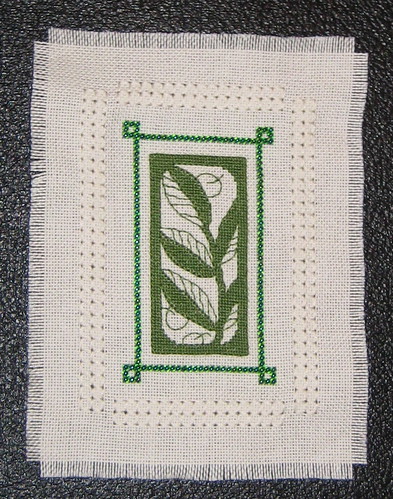Embroidery
 The term "embroidery" actually encompasses several different fabric crafts. In fact, both needlepoint and cross stitch are types of embroidery. Its basic definition is the decorating of fabric and other materials by stitching designs onto it. This can be done with thread, yarn, or ribbon.
The term "embroidery" actually encompasses several different fabric crafts. In fact, both needlepoint and cross stitch are types of embroidery. Its basic definition is the decorating of fabric and other materials by stitching designs onto it. This can be done with thread, yarn, or ribbon.
There are several subcategories of embroidery. Machine embroidery is done with a sewing machine, or with a specialized embroidery machine. Free embroidery is done without taking the weave of the fabric into account, while counted thread embroidery uses patterns that are measured by the number of threads in the fabric. Surface embroidery is done on top of the fabric, while canvas work requires stitching over the entire fabric, in effect making a new fabric.
Embroidery's roots are uncertain, but there is evidence that it goes back at least as far as the Iron Age. Elaborate embroidery designs in clothing were a sign of status in ancient and medieval times. Various forms of embroidery have been passed down through the generations in many cultures.
Cross Stitch
 Cross stitch
Cross stitchMaterials used in cross stitching include embroidery floss and canvas or Aida cloth. Today, cross stitching is most often used in creating pictures for framing. It has historically been done on household items such as dishtowels and linens, and although not as prevalent, it is still frequently used for those purposes.
Needlepoint
 Needlepoint is a surface embroidery technique. Its basic stitch is like a half-stitch in cross stitching. Usually worked on very fine canvas, needlepoint is used to create upholstery, wall hangings, purses, rugs and more. It creates a look similar to that of tapestry, but instead of being woven on a loom, it is stitched by hand.
Needlepoint is a surface embroidery technique. Its basic stitch is like a half-stitch in cross stitching. Usually worked on very fine canvas, needlepoint is used to create upholstery, wall hangings, purses, rugs and more. It creates a look similar to that of tapestry, but instead of being woven on a loom, it is stitched by hand.Embroidery goes back a long way, and it continues to evolve to this day. Cross stitch and needlepoint are two of the most popular types, but they are not the only ones. There are a wide variety of embroidery techniques out there to try.
Which needle and thread handicraft is your favorite?


This comment has been removed by a blog administrator.
ReplyDeleteI would like to make a tote bag with the eyes, nose and whiskers of a cat as a design. Would this be done with embroidery or cross stitch. I can sew but I have never done any of the needle work so I will need to learn.
ReplyDeleteYou could do either just depending on the look your going for
DeleteWow youre so helpful.
DeleteThe article states that cross stitch is a type of embroidery.
DeleteI'm trying to teach myself embroidery and have bought self taught books, YouTube tutorials, etc. Really looking forward to creating something.
ReplyDeleteI am doing my first cross stitch project. It is an embellished stamped kit I got at a thrift store. I love the stitching, it is somehow calming and soothing. I don't like just embellishing though.
ReplyDeleteI have some big ideas of making beautiful things, but am worried I will now try jumping to something too complex.
I've read some people saying counted cross stitch is easier and some saying it is harder than stamped. All have said counted allows for more detail and versatility. It sounds intimidating though, using a blank canvas.
Needlepoint is interesting to me, but sounds even more complex.
Do you recommend jumping right to counted or getting more experience with stamped? Is needlepoint a lot more complex? Thanks for your help.
Really Great collection here. Your post is very helpful for us. Logo merchandise, Calgary Alberta
ReplyDeletePromotional products, Calgary Alberta
This is a really informative article for readers and you have provided an excellent details in your post APPRECIATED!!!.
ReplyDeleteThanks for the tips about the perfection of embroidery work. Its really useful.
ReplyDeleteThis is really informative article for all the related department. I am really impressed from your writing skill.
ReplyDeleteI have deeply read your article and this is really an amazing post and you have described everything about embroidery with efficiency.
ReplyDeleteThis comment has been removed by the author.
ReplyDeleteThanks for clarifying the difference between Cross Stitch, Embroidery and Needlepoint. This is really useful for all embroidery digitizers. Thanks.
ReplyDeleteThis blog is very informative. I love this blog. Keep doing for embroidery digitizing services
ReplyDeleteVery nice blog. Thanks for giving information on Cross Stitch, Embroidery and Needlepoint. it is very much beneficial for Embroidery Digitizer
ReplyDeleteThis is the great blog, this is an amazing blog for Embroidery Digitizing
ReplyDeleteYou have made gorgeous image embroidery and this is really informative blog article to all the beginners for developing their skill on concern field.thank you for sharing.Embroidery Digitizing
ReplyDeleteThanks for sharing such an amazing article, really informative
ReplyDeletevisit here : Beginner cross stitch kit
This is an amazing work.
ReplyDeleteWin Digitizing